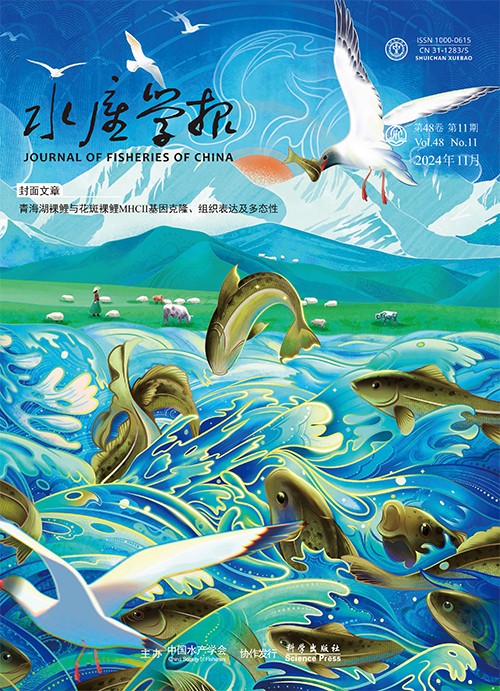Using carbon stable isotope ratio(δ~(13)C)to evaluate contribution of artificial feeds to growth of pond cultured juvenile sea cucumber Apostichopus japonicus(Selenka)
Q4 Environmental Science
引用次数: 3
Abstract
Sea cucumber Apostichopus japonicus(Selenka)is a typical deposit-feeder,that is,food came from some organic matter in sediment such as bacteria,prozotoa,benthic microalgae and detritus of macroalgae.Artificial feeds are applied in some areas for sea cucumber farming to increase production of the pond cultured sea cucumbers,however,to what extent the artificial feed contributes to their growth is still unclear.Study on the food sources by a traditional way of direct gut content analysis has limitations.Stable isotope is a predictable method to evaluate food sources of A.japonicus.The present experiments were conducted to estimate contribution of artificial feed to growth of sea cucumber at five different stocking densities(5,10,15,25 and 35 ind/m2)using a stable carbon isotope ratio(δ13C)tracer.Sea cucumbers with an average weight of(4.78±0.58)g were randomly assigned to the enclosures.The animals were fed with artificial feed at 8:00 every day,at a feeding rate of about 5% wet weight.There were 5 treatments and 3 replicates in the experiment that lasted for 6 months.The control treatments without feed were set simultaneously.A lab experiment with four plastic aquaria(100 cm×60 cm×60 cm)was conducted and feeding time and ration were the same as the pond experiment.The results showed that the final weight and δ13C value of sea cucumbers were affected markedly by both artificial feed and stocking density(P0.05).With stocking density increasing,final weight of the animals decreased from(35.62±3.50)g to(24.59±4.38)g,and with stocking density increasing from 5 ind/m2 to 35 ind/m2,the δ13C values of sea cucumbers decreased from-13.262‰ to-15.102‰(P0.05).Contributions of artificial feed to the growth of the sea cucumbers increased with increasing of stocking density,only 3.78%±2.98% at 5 ind/m2 to 29.48%±3.31% at 35 ind/m2.Previous studies showed that artificial feed contributed 23.0%-61.6% to the growth of shrimp and fish,which is higher than that to A.japonicus.This was caused by quality of artificial feed and the physiological characteristics of feeding behavior of sea cucumbers.利用碳稳定同位素比值(δ~(13)C)评价人工饲料对池养海参幼参生长的贡献
海参(Apostichopus japonicus, Selenka)是一种典型的沉积物食性海参,其食物来源于沉积物中的一些有机物,如细菌、原生动物、底栖微藻和大型藻类的碎屑。人工饲料在一些地区用于海参养殖,以提高池养海参的产量,但人工饲料对海参生长的促进程度尚不清楚。传统的直接肠道含量分析方法对食物来源的研究存在局限性。稳定同位素是评价海参食物来源的一种可预测的方法,本试验采用稳定碳同位素示踪法(δ13C)估算了5种不同放养密度(5、10、15、25和35 ind/m2)下人工饲料对海参生长的贡献。将平均体重为(4.78±0.58)g的海参随机分配到围栏中。每天8:00饲喂人工饲料,投喂率为湿重5%左右。试验分5个处理,3个重复,试验期6个月。同时设置不加饲料的对照处理。采用4个塑料水族箱(100 cm×60 cm×60 cm)进行室内试验,饲养时间和饲料比例与池塘试验相同。结果表明:人工饲料和放养密度对海参最终体重和δ13C值均有显著影响(P0.05);随着放养密度的增加,海参的末重从(35.62±3.50)g下降到(24.59±4.38)g;随着放养密度从5 ind/m2增加到35 ind/m2,海参的δ13C值从13.262‰下降到15.102‰(P0.05)。人工饲料对海参生长的贡献随放养密度的增加而增加,5 ind/m2时仅为3.78%±2.98%,35 ind/m2时为29.48%±3.31%。前人研究表明,人工饲料对虾、鱼生长的贡献率为23.0% ~ 61.6%,高于对日本刺参的贡献率,这与人工饲料的质量和海参摄食行为的生理特性有关。
本文章由计算机程序翻译,如有差异,请以英文原文为准。
求助全文
约1分钟内获得全文
求助全文
来源期刊

水产学报
Environmental Science-Management, Monitoring, Policy and Law
CiteScore
1.40
自引率
0.00%
发文量
5213
期刊介绍:
"Fisheries of" mainly reflects the results of scientific research and development of the direction of aquaculture for domestic and foreign academic exchanges Fisheries Service. Mainly basic research published in Fisheries, aquaculture and proliferation of fishing waters environmental protection, preservation of aquatic products processing and utilization, fishing equipment, and other aspects of mechanical papers, research briefings and reviewed.
 求助内容:
求助内容: 应助结果提醒方式:
应助结果提醒方式:


